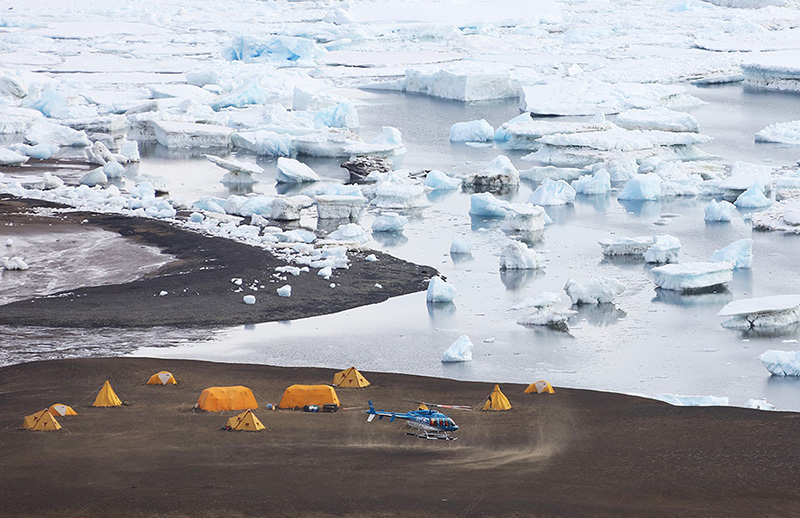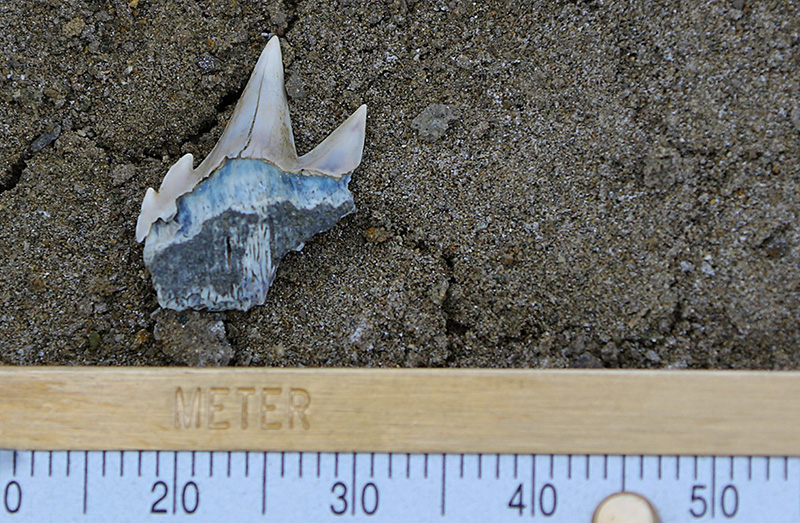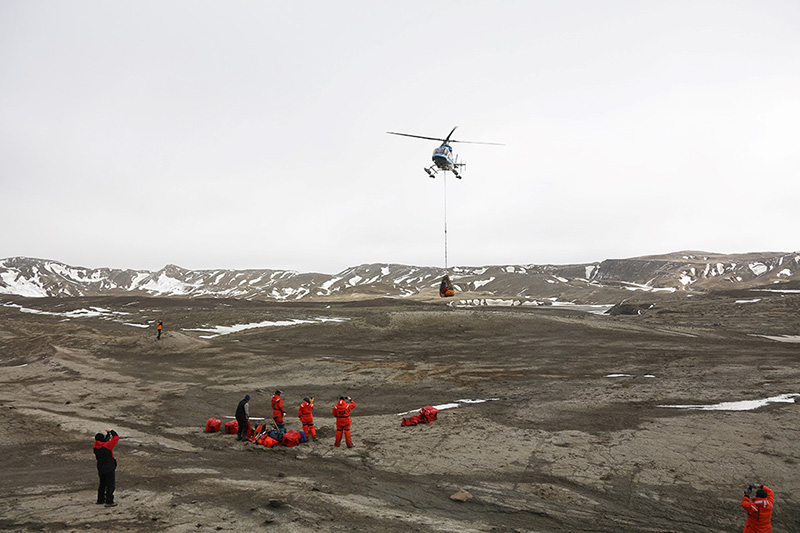Scientists Recover an Abundance of Fossils and Geologic Data from AntarcticaPaleontologists return with a big haul after nearly two months of fossil hunting off the Antarctic Peninsula.Posted May 25, 2016
Using everything from pickaxes to helicopters, paleontologists scoured multiple islands off the Antarctic Peninsula in February and March for the remains of prehistoric beasts and returned with a trove of fossils from the end of the time of the dinosaurs. 
Photo Credit: Meng Jin
The team set up camps along Seymour and Vega islands where prehistoric fossils had been discovered before.
“It was a smashing success, it was fantastic,” said Matt Lamanna, the principal dinosaur researcher at Carnegie Museum of Natural History and lead principal investigator of the project. “This certainly was the most productive Antarctic expedition that I’ve ever been a part of.” Although it will take a great deal of time and analysis before any specific, scientifically defensible finds can be announced to the world, the international team of 12 scientists recovered more than 2,500 pounds of samples comprising more than 300 individual specimens. They found fossils of plants and fish, remains from extinct marine reptiles, numerous ancient shelled invertebrates, bones of prehistoric birds, teeth from early mammals and fragments of dinosaur skeletons they’re still working to properly identify. The effort, known as the Antarctic Peninsula Paleontology Project Antarctica was once a very different place. The continent plunged into its present deep freeze only about 35 million years ago, a short interval on the geological time scale, and fossil evidence shows the region once had a much warmer, more temperate climate, likely similar to the climate of today in the Pacific Northwest of the United States. 
Photo Credit: Meng Jin
Scientists measure a small shark tooth, one of the many prehistoric vertebrate fossils recovered during the expedition.
“Fundamentally what we’re trying to do is capture and characterize this point in Earth’s history and we do that from two different perspectives. One is what were the animals alive at that time and then probably even more important, what were those animals doing in their ecological context,” said Patrick O’Connor, professor of anatomical sciences at Ohio University. “We’re really trying to paint an entire picture of an ecosystem.” Fossil hunting in Antarctica is no easy task. Traveling to the continent is a multiple-day journey on the research vessel Nathaniel B. Palmer from South America across the tempestuous Drake Passage. Once there, there are only a smattering of accessible, fossil-rich sites found on islands along the Antarctic Peninsula. “Part of the problem with Antarctica is that there are so few places you can even look for vertebrate fossils,” said Ross MacPhee, a curator and professor of Mammalogy at the American Museum of Natural History. “Ninety-eight percent [of the continent] is all ice and snow. Even on the Antarctic Peninsula there are just little wedges of land that are not covered all the time by glaciers or snow.” Despite these obstacles, paleontologists found fossils dating as far back as about 71 million years ago and as recently as about 40 million years ago, a timeframe that spans the end of the age of the dinosaurs. The science team mostly lived out of tents on islands along the tip of the peninsula for the five and a half weeks they were fossil hunting. They set up camps on Seymour Island and Vega Island, near the larger James Ross Island. It’s a region that is mostly clear of snow in the summer and one that yielded significant finds on past paleontological expeditions. The focus of this expedition was to look for vertebrate fossils from around the end of the age of the dinosaurs, about 66 million years ago. The science team was made up of paleontologists and geologists with a range of backgrounds. There were experts on ancient fish, primitive mammals, birds, dinosaurs and other extinct giant reptiles. Bringing together so many specialties lets the researchers piece together a more complete understanding of what lived on the ancient Antarctic continent. 
Photo Credit: Meng Jin
Helicopters were a new and welcome addition to paleontologists’ toolkit on this year’s expedition.
“That’s one of the reasons why there are so many collaborators on the project,” said Kerin Claeson, an assistant professor of anatomy at the Philadelphia College of Osteopathic Medicine. “We can then describe all of the different animals that are coming from the region and give you a sense of what the history of the area is like.” Claeson’s expertise is ancient fish. The region that the team was exploring was a shallow sea when the great extinction happened at the end of the Mesozoic Era that wiped out nearly three quarters of all species on Earth, most notably those dinosaurs that didn’t evolve into birds. “I was pretty impressed at some of the areas that we were able to find, and how nicely some of the things were preserved,” she said. “We’re going to get some really nice details to describe the animals that were there.” They found an abundance of shark and other fish remains in the area, including backbone fragments, skulls and whole skeletons. The specimens they collected are still being shipped back to the United States to be identified. Claeson said that even if none of the specimens turn out to belong to new species, the sheer abundance of fossils they discovered can answer many questions about the region’s ancient ecosystem. “Always it’s exciting when you can find something that’s a new species, but when you get a lot of specimens, you can actually start to describe the ecology and the communities that are going on.” Earth was undergoing significant changes around the time that many of these fish fossils were deposited. They straddle the Cretaceous-Paleogene boundary, what scientists refer to as the K-Pg boundary, which marks the sudden mass extinction of most life on Earth. Scientists think the age of the dinosaurs came to an end when a giant asteroid struck the Earth near Mexico’s Yucatan Peninsula about 66 million years ago. “The reason why it’s of interest is because there are actually very, very few places that have vertebrate fossils that are connected with the impactor and the huge die-off that occurred at that time,” MacPhee said. “To find vertebrates in any correlation with what’s called the K-Pg boundary is a big deal.” MacPhee’s own research concentrates on the evolution of mammals, specifically how ancient marsupials and the ancestors of sloths, armadillos and anteaters spread across the southern hemisphere during the age of the dinosaurs. “The big interest was to see if we could find interesting fossils of mammals that are basically in the time frame of 100 million to 65 million [years ago],” MacPhee said. |
"News about the USAP, the Ice, and the People"



For USAP Participants |
For The Public |
For Researchers and EducatorsContact UsU.S. National Science FoundationOffice of Polar Programs Geosciences Directorate 2415 Eisenhower Avenue, Suite W7100 Alexandria, VA 22314 Sign up for the NSF Office of Polar Programs newsletter and events. Feedback Form |


